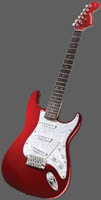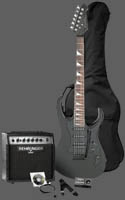
Guitar.org is your source for guitar. Whether it is an electric guitar, acoustic guitar or a classical guitar, this is your resource for guitar music and information.

How to Choose Electric Guitar Strings New!
Guitar strings are measured by the string diameter or thickness. The gauge is represented in inches as a decimal or thousandths of an inch. The name of a set of strings is based on the thinnest string (high E string). A set of strings consisting of .010-inch would be called a set of 10's.
The string gauge you choose is based on your preferred feel (ease of bending strings), technique (heavy percussive attack or light pressure finesse), tuning, preferred tone and the individual instrument.
The scale length of the guitar will change the feel of your strings. A longer scale length guitar such as a Fender Strat or Tele with 25.5" scale length with 10's will feel like a Gibson Les Paul 24.75" scale length with 9's.
If you tune down, consider a heavier gauge string. Generally a half step drop will allow you to go up one string gauge for a similar feel.
Heavier gauge strings will have a fatter tone (accentuated low and mid frequencies) due to the increasued material that the pickups will amplify.
Shorter scale length guitars may benefit from lighter gauge strings to make bending easier.
A beginner may choose 9's or 10's. Most guitars are set up with 9's for ease of play. They will also help if the player has not yet developed callouses. The problem with 9's is the string gauge requires some finesse or else fretted notes may sound out of tune if not careful with pressure. Pusing the string down into the fretboard will increase tension, as will bending the string up or down slightly.
When changing string gauges it may be necessary to adjust the action and intonation of the guitar. Action is the height of the string from the fretboard. Low action makes the instrument easier to play but also increases the buzzing sound as the strings vibrate against the frets. Intonation refers to the adjustment to keep the guitar in tune thoughout the range of the fretboard. A truss rod adjustment may also be necessary due to a change in string tension.
8-xx super extra light
9-42 extra light
10-46 normal light
11-48 medium
12-xx heavy
13-xx extra heavy
There are other combiations of these sizes, often with heavier bottom strings and lighter top strings.
The top three treble strings on an electric guitar are normally plain steel wire, while the lower bass strings are wire wrapped around a steel core. The core wire may also be plated with tin to produce a warmer tone. The wire wound on wrapped strings on an electric guitar are normally nickel plated steel. Other winding materials include pure nickel and stainless steel. Some strings have an additional polymer or enamel coating to help resist corrosion.
The nickel costing on nickle plated steel srings gives the string a smooth feel and reduces the amount of string noise while reducing fret wear. They give a bright sound compared to pure nickle string.
Pure Nickel strings give a warm sound associated with smooth, round vintage tone. These strings are not actually 100% nickel, but an alloy containing nickel.
Stainless steel strings provide a brighter sound for a sharp, cutting tone. They last longer because of their resistance to perspiration and oils. Stainless steel is a very hard material and will increase fret wear.
Brass or bronze will corrode due to perspiration from your hands and the string will lose its brilliant tole. Dirt and oil collect on strings which also dulls the sound.
How long do strings last? When to change strings? This depends on many factors, including how many hours you play, your playing style, your environment and your budget. Performing professionals and studio musicians may change their strings every day, recreational players might go months between string changes. Generally if the sound is dull or you begin breaking strings, it would be a good time to change the whole set.
Tune Your Guitar
One difficulty for beginners at guitar is to keep their instrument in tune. The first thing you should do each time you pick up your guitar is check to make sure it is in tune. A poorly tuned guitar will make anything you play sound bad. Tuning only takes a few seconds once you get the hang of it. The beginner may have difficulty discerning slight differences in pitch, so a digital tuner will help get it right, every time.
Choosing a Beginner Guitar
There are three main types of guitar. The most common is the steel string acoustic. The second type is the nylon string classic guitar. The third type is the ever-popular electric guitar. Most beginning guitarists choose a guitar type that matches their musical preferences. Steel string guitars have a bright sound and need no amplification. The narrow neck makes playing chords easier, but the steel strings require more pressure and the player will grow calluses and adapt over time. The nylon string classical is easier on the fingers, but the wide neck may makes playing chords more difficult. The electric guitar has a neck and strings similar to that of the steel string acoustic, however lighter gauge strings can be used. The electric guitar requires an amiplifier for playing in all but the quietest of environments.



